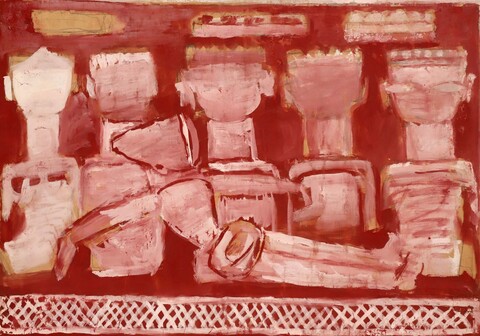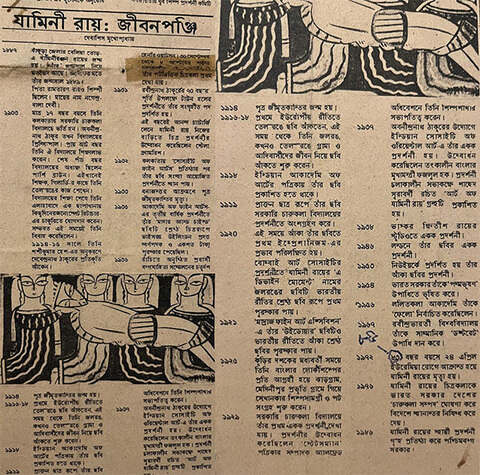From the humble lanes of Beliatore to the grand pages of Indian art history, Jamini Roy's life was a journey of artistic awakening. His artistic journey, deeply rooted in Bengal's folk traditions, reflects a bold departure from the Western academic styles. The following timeline translated from the Bengali text Jamini Roy: Jibonpanji, written by Debasish Mukhopadhyay, presents a chronological account of his life, education, and major achievements.
1887: Jamini Ranjan Roy was born in Beliatore, Bankura district. There is some disagreement regarding his year of birth. According to many, he was born in 1889. His father, Ramataran Roy was also an artist. His mother’s name was Nagendrabala Devi.
.jpg) Jamini Roy with His Paintings
Jamini Roy with His Paintings
1903: At the age of only 17, he was admitted to the Government School of Art, Calcutta. At that time, Abanindranath Tagore was the principal of the institution. He studied there for about 8 years. During the last 5 years, Percy Brown served as the principal. It was here that he learned oil painting under the guidance of his teacher, Gilardi. After completing his studies at the school, he briefly took up a job as a plate re-toucher in a printing press at Allahabad. It was probably this time that he got married.
In 1914-15, he painted a portrait of Debendranth Tagore, following the style of Shashikumar Hesh.
1914: His son Jimutkanti was born.
1916-18: Initially, he painted in the European style. From this time onward, he began painting the lives of rural and tribal people in watercolours and sometimes in oils.
1918: The journal of Indian Academy of Art began featuring his paintings.
1919: His painting was included in the exhibition of the Government School of Art as that of a former student.
1920: During this time, the influence of Impressionism was first evident in his painting.
In the exhibition of the Bombay Art Society, Jamini Roy’s painting ‘A Divine Moment’ received the first prize as the best work in Indian tradition.
1921: At the Madras Fine Art Exhibition, his painting ‘Widower’ received the award for the finest painting in Indian style.
1925: In the mid-1920s, he became interested in the folk art of Bengal and began visiting villages such as Jhargram and Midnapore, where he started collecting local artworks and pata (scroll paintings).
 Untitled (The Unfinished Pieta), Jamini Roy, Circa 1970
Untitled (The Unfinished Pieta), Jamini Roy, Circa 1970
1929: His first solo exhibition was held at the Government School of Art. It was inaugurated by Alfred Henry Watson, the editor of The Statesman. Running from September 30 to October 8, this exhibition showcased his pata-based paintings for the first time.
1931: On the occasion of Rabindranath Tagore’s 70th birth anniversary, his collected works were exhibited at the Town Hall exhibition.
In the same year, Jamini Roy held an art exhibition at his own house on Ananda Chatterjee Lane, which was inaugurated by Stella Kramrisch.
1932: After the establishment of the Society of Fine Arts in Calcutta, his paintings were included in the exhibition organized by the association.
In the same year, his son Jimutkanti passed away in mysterious circumstances.
1935: At the third annual exhibition of the Academy of Fine Arts, his painting ‘Mother and Child’ received the gold medal and a cash prize of one hundred rupees by the then Viceroy Willingdon as the best painting.
1936: At the fourteenth session of the Prabasi Bangasahitya Sammelan held in Ranchi, he presided over the art section.
1937: His solo exhibition was held at the Indian Society of Oriental Art, under the invitation of Abanindranath Tagore. The exhibition was inaugurated by Fazlul Haq, then Chief Minister of Bengal. During the exhibition, the book ‘Art of Jamini Roy’, written by Shahid Suhrawardy, was published in the conference hall.
 Jamini Roy: Jibonpanji, Written by Debasish Mukhopadhyay
Jamini Roy: Jibonpanji, Written by Debasish Mukhopadhyay
1938: A solo exhibition was organized at the studio of the sculptor Kshitish Roy.
1946: His paintings were showcased in a solo exhibition in London.
1953: An exhibition featuring his paintings took place in New York.
1954: The Government of India conferred upon him the Padma Bhushan award.
1956: He received the honor of ‘Fellow’ from the Lalit Kala Akademi.
1967: Rabindra Bharati University bestowed on him the title of honorary ‘Doctorate’.
1972: On 24th April, at the age of 85, Jamini Roy passed away after suffering from uremia.
1976: Jamini Roy’s artworks were declared national fine art treasure by the Government of India, forbidding its export overseas.
1986: The West Bengal Government established a permanent gallery of Jamini Roy’s artworks.
REFERENCE
Jamini Roy: Jibonpanji by Debasish Mukhopadhyay (Jamini Roy: Timeline)